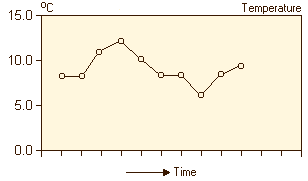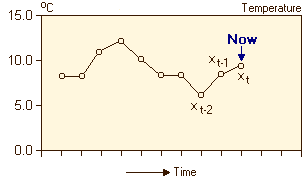 You are working with the text-only light edition of "H.Lohninger: Teach/Me Data Analysis, Springer-Verlag, Berlin-New York-Tokyo, 1999. ISBN 3-540-14743-8". Click here for further information.
You are working with the text-only light edition of "H.Lohninger: Teach/Me Data Analysis, Springer-Verlag, Berlin-New York-Tokyo, 1999. ISBN 3-540-14743-8". Click here for further information.
 You are working with the text-only light edition of "H.Lohninger: Teach/Me Data Analysis, Springer-Verlag, Berlin-New York-Tokyo, 1999. ISBN 3-540-14743-8". Click here for further information. You are working with the text-only light edition of "H.Lohninger: Teach/Me Data Analysis, Springer-Verlag, Berlin-New York-Tokyo, 1999. ISBN 3-540-14743-8". Click here for further information.
|
Table of Contents  Bivariate Data Bivariate Data  Time Series Time Series  Introduction Introduction |
|
| See also: forecasting, trends |   |
A time series consists of several values which are ordered in time. For instance, when writing down the outside temperature each morning at 8 am, the resulting time series may be as follows:
8°C, 8°C, 11°C, 12°C, 10°C, 8°C, 8°C, 6°C, 8°C, 9 °C

These observations are made at equidistant points in time, i.e. the intervals have the same length. This is typical for real time series. In this case, the temperature is checked every 24 hours. This interval is also referred to as the time lag [t, tau] between the observations. This time series is a univariate time series, because a single variable is involved. When checking several variables, as for instance when additionally checking the wind speed and the humidity, one speaks of a multivariate time series.
Let´s call the single variable of the univariate time series x.
The temperature observed today is denoted x(t), x at time t. Then, x(t-1),
x(t-2), ...x(t-m) are the preceding values, whereas x(t+1), x(t+2), ...x(t+n)
are the future observations.

Last Update: 2005-Jul-16